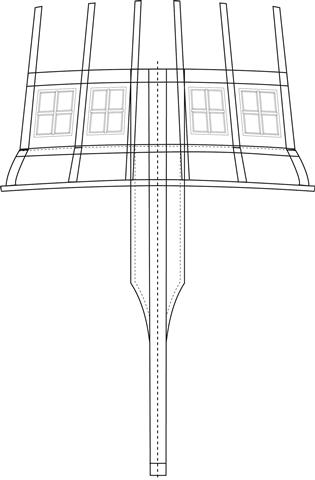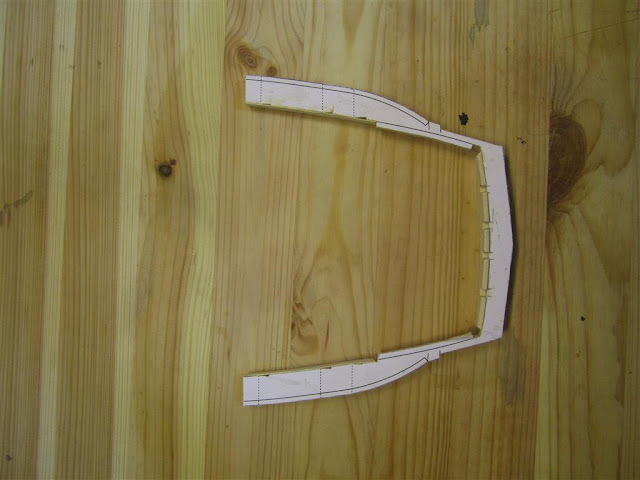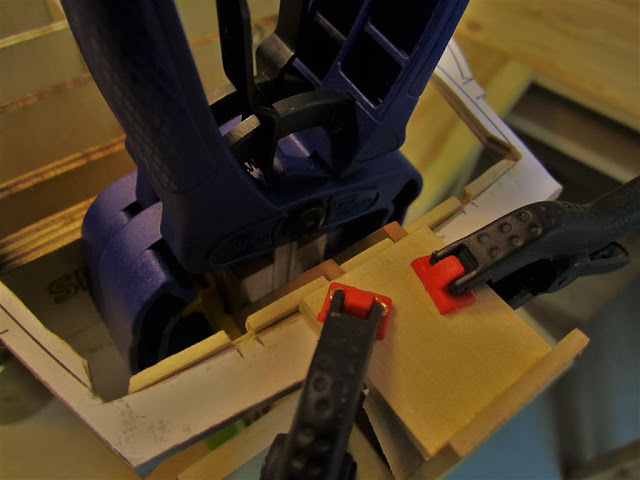There are few secret places left to be explored in the world; but there
is one waiting under the waters of Terror Bay.
The announcement that HMS Terror was recently found "in pristine condition" is
astonishing, yet the revelation that the ship's stern lights (stern cabin
windows) have survived intact is especially poignant. Behind those 171-year-old stern lights is the very definition
of a secret space; the cabin where Captain Crozier received reports and
dispatched orders; where he entertained Franklin, Fitzjames and his officers in
the better days; and where he huddled over his charts, plotting and planning
his men’s desperate escape from the ice.
By 1845, Terror’s stern
windows were very different from those Captain John Sheridan gazed through as
he bombarded Baltimore in 1814. In 1812, Henry Peake designed a relatively
traditional stern gallery for HMS Terror,
which included seven stern lights in addition to six windows arranged on her port
and starboard quarter galleries. Each of the stern windows had nine panes,
while the smaller quarter gallery windows had six panes.
 |
| Henry Peake's original 1812 design for Terror's stern gallery and quarter galleries. NMM, ZAZ5662 |
When Terror was first converted
for polar service over 1835 and 1836, its vulnerable quarter galleries (and the
water closets they contained) were removed, resulting in a reduction to five
stern windows. Contemporary artwork by Owen Stanley indicates that the windows
retained their original nine-pane configuration during Back's harrowing Arctic expedition
of 1836-1837.
 |
| Terror's stern lights in 1837. Note the cipher and ship's name depicted above the hanging rudder. NMM, PAF0275 |
Since the time of Parry’s second Arctic voyage, 24 years previously,
polar exploration vessels had been fitted with "double window-frames"
(1), and Terror undoubtedly had
double windows installed for Back’s 1836 -1837 Arctic voyage. Parry described
that during the coldest months, "cork shutters" were inserted between
the sashes on HMS Hecla (1), and it
is possible that cork shutters were used on Terror’s subsequent polar voyages.
Contemporary images suggest that Terror's
stern gallery remained unchanged during the Antarctic expedition of 1839-1843,
when Terror was under the command of
Francis R.M. Crozier, although the 1839 Terror
and Erebus plans indicate that significant changes were made to the great cabin itself.
In the spring of 1845, Terror
and Erebus had their sterns
dismantled and reconstructed to accommodate large wells needed to raise and
lower their new screw propellers. The centre window on the stern of each vessel
was removed to make room for the new well. Green-ink annotations on Terror’s 1836 plans show that her stern
frames were shifted slightly forward during the 1845 refit. The reasons for
such an extensive refit are unclear, but it may have been necessary to redesign
the stern framing to accommodate the weight and stress of the new
propeller system.
While it appears that the remaining four stern windows were kept (roughly) in their original positions in 1845, the windows themselves were
redesigned from a nine-pane to a four-pane configuration. We know this because
of a remarkable woodcut of the great cabin of HMS Erebus, which appeared in the May
24th, 1845 issue of the Illustrated London News (2). The accompanying
article described that the windows were “double[d]”, similar to those used on
Parry’s voyages. Astonishingly, high resolution images of the cabin
illustration in the report clearly show the double sashes.
| The Great Cabin of HMS Erebus, as depicted in a woodcut from the May 24th, 1845 edition of the Illustrated London News |
Why the stern lights were modified to a four-pane design is unknown, but
the woodcut indicates that by 1845 the window muntins were much more robust
than those on a typical stern window. A sturdier design might have been thought necessary, after the unprecedented heavy seas and storms Terror and Erebus encountered
during their Antarctic expedition. However,
we know that the thickness of the glass was not increased, because window glass
recovered
from HMS Erebus in 2015 has the same thickness as that specified on Terror’s (i.e., Belzebub’s) original 1812 building contract (3).
Below, I’ll outline how I have recreated Terror’s windows for my model. Though few pictures have been
released, they appear to compare well with the recent Parks
Canada images of Terror’s stern. The great cabin on
the other side of those windows was the nerve-center of the living ship, where all
the achievements, misfortunes, and decisions of the expedition were debated,
decided, and recorded. In the coming years, it is a place where all the
expedition’s mysteries may be revealed.
References:
(1) Parry, William Edward. 1824. Journal of a Second Voyage
for the Discovery of a North-west Passage from the Atlantic to the
Pacific: Performed in the Years 1821- 22-23, in His Majesty's Ships Fury
and Hecla, Under the Orders of Captain William Edward Parry, R.N., F.R.S., and
Commander of the Expedition. London.
(2) Departure of the “Erebus” and “Terror” on the
Arctic Expedition. Illustrated London News, May 24th, 1845. Volume
6, Page 328.
(3) National Maritime Museum, ADT0010
 |
| Construction of the stern windows began with laser cutting the sashes from a sheet of Swiss pear. |
 |
| A bevel was added to each muntin with a hand file. The filed windows are on the left, the unfinished windows are on the right. |
 |
| Comparing progress to the original woodcut. |
 |
| Instead of adding four individual panes, I opted to add a single simulated pane. This was achieved by carving out the backside of the windows to accept the simulated glass. |
 |
| A beading line of CA was used to glue the panes in place. |
 |
| Allowing the glue to dry. |
 |
| A pair of finished windows compared to the woodcut. Note the double sashes in the woodcut image. |
 |
| Gluing the sills to the sashes. These are not the proper configuration, but will not be visible on the finished model. |
 |
| A nickle for scale. |
 |
| The completed double windows. |
 |
| A closeup view. |
 |
| The interior panes were sanded to simulate frost (and to prevent a view into the interior of the model). |
 |
| The port stern lights installed between the stern frames. |
 |
| A view from the interior of the model. The imposing nature of the well can be seen here. |
 |
| Approximating the view from the great cabin (as best possible). |
 |
| The completed stern gallery. |
 |
| Mini-Cozier surveys the pack from the comfort of his great cabin. |
























































